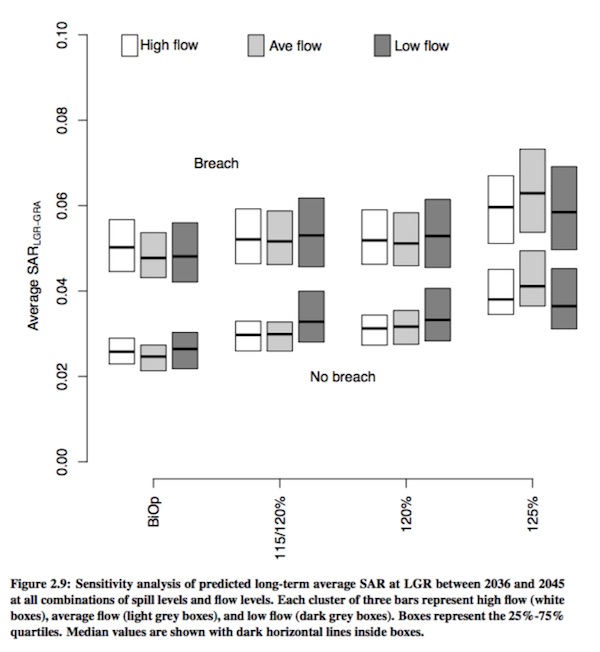forum
library
tutorial
contact

Fish Woes Debated
by Salmon Panelists
by Hunter Diehl
Challis Messenger, October 30, 2019
|
the film forum library tutorial contact |

|
Fish Woes Debated
by Hunter Diehl
|
 John Freemuth asked five experts how the city of Salmon can save its namesake from decline during a panel discussion Oct. 22, and the answer the moderator received was that people need to let their voices be heard.
John Freemuth asked five experts how the city of Salmon can save its namesake from decline during a panel discussion Oct. 22, and the answer the moderator received was that people need to let their voices be heard.
"We need to make noise," said Cleve Davis, a member of the Shoshone-Bannock tribe and editor of the Journal of Native Sciences. "We need to know where the front line is. Is it in Congress? Is it in Salmon?"
Other panelists echoed this sentiment. Aaron Lieberman, the executive director of Idaho Outfitters and Guides Association, said if the people of Salmon want to retain their "spiritual connection to the town's totem" then they need to make noise. He said the biggest impact of declining salmon numbers is the loss of community around fishing. He said Salmon would lose its identity if the problem isn't reversed.
"If we lose our sense of self, we've lost the most important thing we are fighting for," said Lieberman.
Account Executive John Williams with the Bonneville Power Administration, a self-funded federal power marketer that deals mostly in hydropower, said the BPA is doing what it can to address the issue. He said BPA works with other agencies to protect endangered salmon and steelhead in the Columbia River Basin.
On the other hand, Williams said the BPA is responsible to its customers. People rely on dams built on the Snake and Columbia rivers and managed by the BPA for electricity. He said the BPA is committed to saving fish, but the effort must be balanced with consumer needs.
This balance became the main topic of discussion among the panelists, who tried to work out a way to save salmon without eliminating hydropower.
Senior scientist for Trout Unlimited Helen Neville said no perfect balance exists. She said research shows the best option for restoring salmon in Idaho is removing dams and allowing rivers to return to their natural flow.
Project Coordinator Jim Norton of Columbia Redivia supported Neville's idea. An expert at examining hydropower's effects on salmon, Norton presented several studies conducted on the Snake River that claim the only way to restore salmon to historic numbers would be to remove the four dams on the river. These dams impede the fish's ability to travel from freshwater rivers to the Pacific Ocean to reproduce.
BPA's Williams countered this idea and said fish hatcheries in the Columbia River Basin could be a reliable source of salmon and other fish in the future. He said money made from the dams is being used to revitalize salmon populations in these hatcheries.
Neville said this idea is well-intended, but not viable. She said fish hatcheries hurt natural-born fish because of the way domestication affects them. She said research shows domestication alters a fish's genes, making its chance to survive outside of a hatchery small.
Freemuth asked Neville if science supports her claims, then why hasn't any work been done to act on them. She responded by saying the message is clear and "the science is there." She said the problem lies in the delivery of the message and concerned parties need to find a way to make the science more understandable.
The panelists agreed one way to clarify things is to couch the issue in economic terms. Merill Beyeler, a rancher and member of Gov. Brad Little's salmon work group, made the point that salmon fishing has been part of Idaho's recreational history since the early 1800s. He said since about 90 percent of salmon redds, which are depressions made in a riverbed by a female salmon where she lays her eggs, happen on private land it would be worthwhile to get more private citizens and anglers involved in the issue.
Lieberman, who is also on Little's task force, agreed. He said sport fishing generated more than $540 million last year. Lieberman said this figure comes from Idaho Fish and Game and shows the importance of salmon and other fish to Idaho's economy.
The general consensus among the panelists by the end of the discussion was with the continually dropping number of salmon in Idaho, there is a real threat to many facets of Idaho's culture. They agreed more work should be done to save salmon, but were unclear as to how to do that.
"We have not solved the riddle, but we're working at it," said Beyeler.
learn more on topics covered in the film
see the video
read the script
learn the songs
discussion forum
